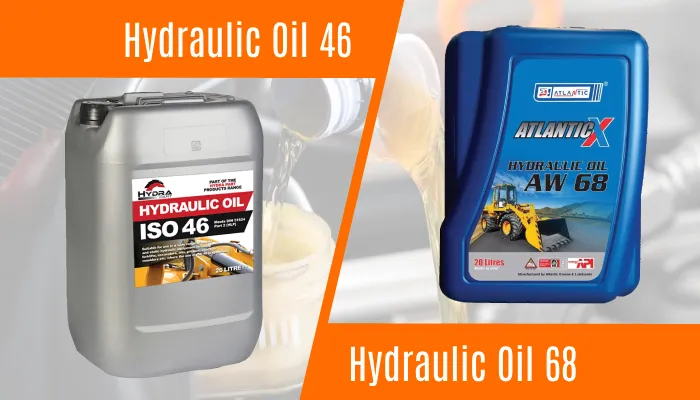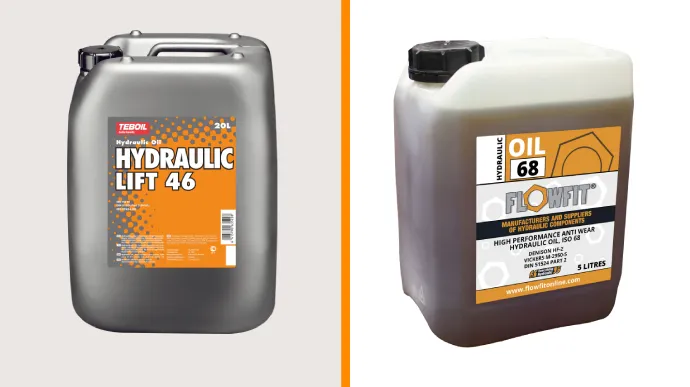Physical Address
304 North Cardinal St.
Dorchester Center, MA 02124
Physical Address
304 North Cardinal St.
Dorchester Center, MA 02124

When working with hydraulic systems, you may have encountered the terms “Hydraulic Oil 46” and “Hydraulic Oil 68.” These two different types of hydraulic oils are used to lubricate and cool the hydraulic systems in various machines, and they differ in their viscosity (thickness of the oil).
Hydraulic Oil 46 has a lower viscosity and medium density, which is more energy efficient for lower temperatures and smoother circulation. However, hydraulic Oil 68 has a higher viscosity and thicker density, which provides better lubrication and wear protection under heavy loads.
Throughout this article, we’ll explore the uses and compatibility of these two grades of hydraulic oil. So keep reading to find out what hydraulic oil is commonly used and which one is recommended.

When comparing hydraulic oil 46 and 68, there are several key differences to consider.
To understand the differences between Hydraulic Oil 46 and 68, compare their viscosities at 40°C. Viscosity is a measure of an oil’s resistance to flow, and it determines how easily the oil can circulate through the hydraulic system.
Hydraulic Oil 46 has a viscosity of 46 ± 5 cSt at this temperature, while Hydraulic Oil 68 has a viscosity of 68 ± 5 cSt. The numerical disparity between the two viscosities is significant and impacts the flow characteristics of the oils.
In general, higher viscosity oils like Hydraulic Oil 68 provide better lubrication and wear protection at high temperatures and heavy loads. Conversely, lower-viscosity oils like Hydraulic Oil 46 offer improved energy efficiency and flowability at lower temperatures.
Hydraulic Oil 46 is designed to perform well in cold or winter conditions due to its lower viscosity. This lower viscosity allows the oil to flow more easily at lower temperatures, ensuring smoother circulation and operation of hydraulic systems.
In contrast, Hydraulic Oil 68 has a higher viscosity and is better suited for summer or warmer environments. The higher viscosity provides better lubrication and protection at higher temperatures, preventing excessive oil thinning and maintaining optimal performance.
The pour point of Hydraulic Oil 46 and Hydraulic Oil 68 differs, impacting their performance in varying temperature conditions. The pour point is the lowest temperature at which the oil will flow.
Hydraulic Oil 46 has a lower pour point compared to Hydraulic Oil 68. This means that Hydraulic Oil 46 is better suited for colder temperatures, as it can flow at lower temperatures without becoming too thick.
Alternatively, Hydraulic Oil 68 has a higher pour point, making it more suitable for warmer temperatures. When used in cold winter conditions, Hydraulic Oil 68 may become thicker and affect cold start performance.
Hydraulic Oil 46 and Hydraulic Oil 68 differ in air release values, directly impacting their performance in hydraulic systems.
Air release values indicate the speed at which air is released from the hydraulic oil. Hydraulic Oil 46 has an air release value of no more than 10 minutes, while Hydraulic Oil 68 has an air release value of no more than 13 minutes.
The lower air release value of Hydraulic Oil 46 indicates faster air release and better air release performance. This is crucial in hydraulic applications where air bubbles can cause issues such as reduced efficiency, increased heat generation, and damage to system components.
When selecting between Hydraulic Oil 46 and Hydraulic Oil 68, consider their application range based on factors such as operating temperature and pump type.
Hydraulic Oil 46 is suitable for a wide range of operating temperatures, typically between -20°C to 80°C (-4°F to 176°F). It’s commonly used in systems where the operating temperature remains relatively stable.
On the other hand, Hydraulic Oil 68 is designed for higher operating temperatures, typically between -5°C to 100°C (23°F to 212°F). It’s recommended for systems that experience higher temperature fluctuations or require increased thermal stability.
Also, the type of pump used also plays a role in the selection process. Certain pumps, such as vane pumps, may perform better with Hydraulic Oil 46, while others, like piston pumps, may require Hydraulic Oil 68 for optimal performance.
Shear stability refers to the oil’s ability to maintain its viscosity under the high-pressure conditions and mechanical stress experienced in hydraulic systems.
Hydraulic Oil 68 generally exhibits better shear stability compared to Hydraulic Oil 46. This means that when subjected to significant mechanical stress, Hydraulic Oil 68 is less likely to experience viscosity breakdown, ensuring consistent performance over time.
The superior shear stability of Hydraulic Oil 68 makes it particularly suitable for applications where the hydraulic system operates under heavy loads or experiences continuous high-pressure conditions.
If you’re deciding between Hydraulic Oil 46 and 68 for specific equipment, consider their differences in viscosity and performance.
Hydraulic Oil 46, with its thinner viscosity, is commonly used in power steering systems, diggers, excavators, and compressors—this type of equipment benefits from a hydraulic fluid that flows easily and provides smooth operation.
Meanwhile, Hydraulic Oil 68, with its thicker viscosity, is suitable for equipment like machining headstocks, tipping gear, and vane and gear pumps. These types of equipment require a higher viscosity fluid to ensure optimal performance and lubrication.
| Characteristic | Hydraulic Oil 46 | Hydraulic Oil 68 |
| Viscosity at 40°C (cSt) | 46 ± 5 | 68 ± 5 |
| Temperature Suitability | Suitable for colder weather; better circulation in low temperatures | Suitable for warmer weather; optimal for summer conditions |
| Pour Point | Lower pour point; better performance in cold start situations | Higher pour point may thicken in cold conditions, impacting start-up |
| Air Release Value (minutes) | ≤ 10 minutes | ≤ 13 minutes |
| Shear Stability | Slightly lower shear stability | Typically better shear stability, less viscosity breakdown under stress |
| Common Equipment Usage | Power steering, diggers, excavators, compressors | Machining headstocks, tipping gear, vane and gear pumps |
| Impact on Energy Efficiency | More energy-efficient in colder conditions | More energy-efficient in warmer conditions |
| Compatibility and Mixing | Mixing not recommended, may lead to issues | Mixing not recommended, may affect oil quality and system performance |

Hydraulic Oil 46 is commonly used for various applications, providing effective lubrication and performance in modern hydraulic systems. It’s specifically designed to meet the requirements of hydraulic equipment and ensure smooth operation.
This type of oil has a viscosity grade of 46, which means it has a moderate thickness that allows it to flow smoothly through hydraulic components. Hydraulic Oil 46 suits various hydraulic systems, including industrial machinery, construction equipment, and agricultural machinery.
It’s also commonly used for lubricating bearings and spur gears in machine tools. Its excellent thermal stability and resistance to oxidation make it ideal for high-pressure systems, ensuring optimal performance and preventing component wear.
The ISO 68-grade hydraulic oil is commonly used for high-pressure hydraulic systems, providing optimal lubrication and performance. It’s specifically designed for applications where pressures exceed 1000 psi, making it suitable for hydraulics with vane, piston, or gear-type pumps.
This grade of hydraulic oil is capable of withstanding the intense pressure and heat generated by these systems, ensuring smooth operation and preventing wear and tear on the components.
Additionally, 68-grade hydraulic oil can also be used to lubricate lightly loaded reciprocating compressors. Its viscosity characteristics allow it to flow efficiently through the system, providing the necessary lubrication to protect the moving parts.
Mixing ISO 46 and 68 hydraulic oil isn’t recommended due to potential performance compromise and increased mechanical wear.
Hydraulic oils have different viscosity grades, determining their flow characteristics and ability to provide lubrication and hydraulic power. ISO 46 hydraulic oil has a lower viscosity than ISO 68, meaning it flows more easily.
Mixing these two grades can result in an oil with an inconsistent viscosity, leading to inadequate lubrication and reduced hydraulic performance. Also, the different additives and properties in each grade can interact unfavorably, causing corrosion of component surfaces and increased mechanical wear.
You can use ISO 46 and 68 hydraulic oil in your John Deere tractor. These hydraulic oils were specifically developed for John Deere equipment, but they can also be used in other non-John Deere machines.
ISO 46 and 68 are viscosity grades that indicate the thickness of the oil. ISO 46 oil has a thinner consistency, while ISO 68 oil is slightly thicker. When choosing between the two, consider the operating temperature and the load requirements of your tractor.
ISO 46 oil suits moderate temperature conditions and lighter loads, while ISO 68 oil is better for higher temperatures and heavier loads. Regularly check the oil level and condition to ensure optimal performance and extend the lifespan of your John Deere tractor.
Like a well-oiled machine, using the right hydraulic oil is crucial for smooth operation. The differences between hydraulic oil 46 and 68 primarily lie in their viscosity. Hydraulic oil 46 is typically used for lighter applications, while hydraulic oil 68 is better suited for heavier machinery.
Choosing the wrong hydraulic oil can lead to various issues, so it’s vital to select the appropriate viscosity and operating temperature for your specific machine. Also, it isn’t recommended to mix these two grades of oil, as it can affect the performance and efficiency of your hydraulic system.